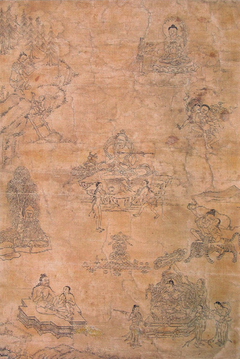Prayer to Eight Mahāsiddhas
༄༅། །གྲུབ་ཆེན་བརྒྱད་ཀྱི་གསོལ་འདེབས།
In Praise of the Eight Mahāsiddhas
by Dolpopa Sherab Gyaltsen
ཀུན་མཁྱེན་སྐྱིད་ཕུག་སུ་བྱོན་ནས། ཨེ་ཝཾ་སྒྲ་སྒྲུབ་ཚར་གཅིག་གསུངས་དུས་སུ་ཐ་སྐར་གྱི་ཟླ་བའི་ཚེས་བཅོ་ལྔའི་སྔ་དྲོ་ལ་ནམ་མཁའ་དྭངས་བའི་དཀྱིལ་དུ་འཇའ་འོད་སྣ་ཚོགས་ཀྱི་གུར་ཁྱིམ་གྱི་དབུས་སུ་རྡོ་རྗེ་འཆང་དང་གྲུབ་ཆེན་བརྒྱད་བྱོན་ནས། བྱིན་རླབས་དང་ལུང་བསྟན་མཛད་དེ། ཁྱད་པར་དུ་ཨིནྡྲ་བྷོ་དྷི་ལས་སེམས་འགྲེལ་སྐོར་གསུམ་གསན་ནོ། དེའི་ཚེ་ན་འདི་སྐད་གསུངས་སོ། །
When the Omniscient One was staying at the Kyi Pug retreat cave, on the morning of the 15th day of the 9th month, having recited one round of Evam, in a clear sky appeared a swirling pavilion of rainbow light with Vajradhara and the Eight Mahāsiddhas appearing in the middle. Receiving blessings and profound scriptural readings, especially that of the 'Sem Drel Kor Sum' from Indrabhuti, at that time he recited:
ན་མོ་གུ་རུ་བྷྱཿ
namo guru bhye
Namo Gurubhyaḥ!
ནམ་མཁའི་མདོག་ཅན་ཆོས་སྐུ་རྡོ་རྗེ་འཆང་། །
namkhé dokchen chöku dorjé chang
Dharmakāya Vajradhara having the colour of the sky,
འགྱིང་བག་རུས་རྒྱན་རྡོ་རྗེ་དྲིལ་བུ་འཛིན། །
gying bak rügyen dorjé drilbu dzin
Majestic with bone ornaments, holding a vajra and bell,
མཁའ་སྤྱོད་དཀར་དམར་མཁའ་འགྲོ་ཡུམ་དང་བཅས། །
khachö kar mar khandro yum dangché
Together with the ḍākinī consort pink Khechari;
ཕ་མཆོག་རྡོ་རྗེ་འཆང་ལ་གསོལ་བ་འདེབས། །
pa chok dorjé chang la solwa deb
To the supreme father Vajradhara I praise.
ཀུར་གུམ་མདངས་ལྡན་ཀླུ་སྒྲུབ་འཛམ་གླིང་རྒྱན། །
kur gum dangden ludrub dzamling gyen
Nāgārjuna, radiantly saffron, ornament of the Southern Continent,
ནགས་ཀྱི་ལྷ་མོས་འཆི་མེད་བདུད་རྩི་ཕུལ། །
nak kyi lha mö chimé dütsi pul
With a forest goddess offering the nectar of immortality,
དངོས་གྲུབ་བརྙེས་ནས་གཞན་དོན་རྒྱུན་མི་འཆད། །
ngödrub nyé né zhendön gyün mi ché
Having gained the attainments, teaching uninterruptedly for the benefit of others;
མཁས་མཆོག་གྲུབ་ཆེན་ཞབས་ལ་གསོལ་བ་འདེབས། །
khé chok drubchen zhab la solwa deb
To the great accomplished one of supreme space I praise.
ཨིནྡྲ་བྷུ་ཏི་ལྗང་སྔོན་དུ་བའི་མདོག །
indra bhu ti jangngön duwé dok
Indrabhūti, the colour of bluish smoke,
རྒྱལ་རིགས་སྤྱོད་པ་ཨོ་རྒྱན་གནས་སུ་བཞུགས། །
gyalrik chöpa orgyen né su zhuk
Dwelling in the land of Orgyan in the manner of royalty,
སྲས་དང་ལྷན་ཅིག་མཁའ་སྤྱོད་ཞིང་དུ་གཤེགས། །
sé dang lhenchik khachö zhing du shek
Together with [his] son departing for Khechara;
གསང་སྔགས་བསྟན་འཛིན་ལ་གསོལ་བ་འདེབས། །
sang ngak tendzin la solwa deb
To the holder of the teachings of Secret Mantra I praise.
རྒྱལ་བའི་མཆོག་ཊྃ་བི་ཧེ་རུ་ཀ །
gyalwé chok tam bi heruka
Ḍombī Heruka, the supreme prince,
སྨུག་ནག་གཅེར་བུས་རྫུ་འཕྲུལ་སྟག་ལ་ཞོན། །
muknak cherbü dzutrul tak la zhön
Maroon and naked, riding on an emanated tiger,
གདིང་བ་བཏིང་ནས་ཆུ་བོ་གངྒཱ་བརྒལ། །
dingwa ting né chuwo gangga gal
Crossing the Ganges River seated on a mat;
རྫུ་འཕྲུལ་དབང་ཐོབ་ཞབས་ལ་གསོལ་བ་འདེབས། །
dzutrul wang tob zhab la solwa deb
To the feet of the Lord of emanated power I praise.
བྲམ་ཟེ་ཆེན་པོ་དཔལ་ལྡན་སཱ་ར་ཧཱ། །
dramzé chenpo palden sa ra ha
Saraha, glorious great Brahmin, golden in colour,
གསེར་མདོག་ཉོན་མོངས་འབིགས་མདའ་སྤྱོད་ཅིང་། །
ser dok nyönmong bik da chö ching
Using an arrow to pierce afflictions,
དཔལ་གྱི་རི་ཡི་གནས་སུ་ནམ་མཁར་གཤེགས། །
pal gyi ri yi né su namkhar shek
Flying in the sky to the land of Śrī Parvati;
རླུང་སེམས་དབང་ཐོབ་ལ་གསོལ་བ་འདེབས། །
lungsem wang tob la solwa deb
To the One who has obtained the power of air-mind I praise.
གྲུབ་ཆེན་རས་མའི་མདོག་ཅན་དྲིལ་བུ་པ། །
drubchen ré mé dokchen drilbu pa
Great adept Ghaṇṭapa having the colour of cotton,
ཡུམ་སྲས་འཇའ་གུར་འཁྱིལ་བའི་འོད་ལམ་དུ། །
yumsé ja gur khyilwé ö lam du
On a trail of light twisting in a rainbow canopy with the consort and son,
རྡོ་རྗེ་དྲིལ་བུ་བསིལ་ནས་ནམ་མཁར་གཤེགས། །
dorjé drilbu sil né namkhar shek
Flying into the sky ringing a vajra and bell;
མཁའ་སྤྱོད་དབང་ཐོབ་ཞབས་ལ་གསོལ་བ་འདེབས། །
khachö wang tob zhab la solwa deb
To the one who has obtained the power of Khechara I praise.
ཀར་ཤམ་མདོག་ཅན་དཔལ་ལྡན་ཀུ་ཀུ་རི། །
kar sham dokchen palden kukuri
Glorious Kukkurīpā, whitish-grey,
མྱོས་བྱེད་མཁའ་འགྲོ་ཁྱི་གཟུགས་བཾ་ནས་རོལ། །
nyöjé khandro khyi zuk bam né rol
Madly playing with a ḍākinī in the form of a dog,
དངོས་གྲུབ་བརྙེས་ནས་ཐོག་མེད་མཁ་ལ་གཤེགས། །
ngödrub nyé né tokmé kha la shek
Acquiring the attainments and without obstruction flying into the sky;
གྲུབ་ཆེན་རྒྱལ་པོའི་ཞབས་ལ་གསོལ་བ་འདེབས། །
drubchen gyalpö zhab la solwa deb
To the feet of the king of great accomplishment I praise.
དུད་ཁའི་མདངས་ལྡན་རྒྱལ་སྲས་ལུ་ཧཱི་པ། །
dükhé dangden gyalsé lu hipa
Royal prince, Luipa, of smoky radiance,
གདུག་པའི་ཉ་ལྟོས་གསོལ་ནས་དངོས་གྲུབ་བརྙེས། །
dukpé nya tö sol né ngödrub nyé
Acquiring the attainments eating the guts of cruel fish,
དགེ་སློང་ཚུལ་འཛིན་འཁོར་བའི་རྒྱ་མཚོ་བརྒལ། །
gelong tsul dzin khorwé gyatso gal
Crossing the ocean of existence [while] keeping the behaviour of a monk;
བརྟུལ་ཞུགས་མཆོག་ལྡན་ཞབས་ལ་གསོལ་བ་འདེབས། །
tulzhuk chokden zhab la solwa deb
To the feet of the one holding the supreme conduct I praise.
པདྨ་བཛྲ་མདོག་དཀར་ཁྱིམ་པའི་གཟུགས། །
pema benza dok kar khyimpé zuk
Padmavajra in the form of a layman, white in colour,
ཤིང་ཏོག་གསོལ་ཞིང་ལམ་མཆོག་བསྒོམ་པར་མཛད། །
shingtok sol zhing lam chok gompar dzé
Performing the path of supreme meditation and eating only fruit,
རྫུ་འཕྲུལ་སྟག་མོ་བཅིབས་ཏེ་ནམ་མཁར་གཤེགས། །
dzutrul takmo chib té namkhar shek
Flying in the sky, riding an emanated tigress;
གདུག་ཅན་འདུལ་མཛད་ཞབས་ལ་གསོལ་བ་འདེབས། །
dukchen dul dzé zhab la solwa deb
To the feet of the one who subdues evil I praise.
གྲུབ་ཆེན་བརྒྱད་ལ་གསོལ་བ་བཏབ་པའི་མཐུས། །
drubchen gyé la solwa tabpé tü
Through the power of this praise,
བདག་ཅག་དཔོན་སློབ་ཡོན་མཆོད་འཁོར་བཅས་ཀྱི། །
dakchak pönlob yönchö khor ché kyi
May we together, teachers, students and sponsors,
གནས་སྐབས་ཀུན་ཏུ་མི་མཐུན་བར་ཆད་སེལ། །
nekab küntu mitün barché sel
I request, at all times be free from negative obstacles
མཐུན་པའི་ལམ་སྣ་ཆོས་ལ་དྲང་དུ་གསོལ། །
tünpé lam na chö la drang du sol
And be taken onto the positive Dharma path.
ཅེས་གྲུབ་ཆེན་བརྒྱད་ཀྱིས་ཞལ་གཟིགས་པའི་དུས་སུ་ཀུན་མཁྱེན་ཆེན་པོས་མཛད་པའོ།། མངྒ་ལཾ།།
Written at the time of the Great Omniscient one having seen the faces of the Eight Great Accomplished Ones.
| Translated by Jeff Watt, 2004. Originally published on Himalayanart.org Reproduced with permission.
